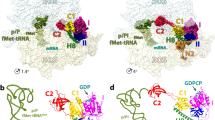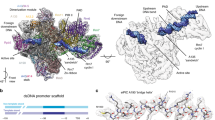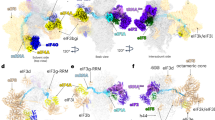Abstract
INITIATION factor 3 (IF3) and ribosomal protein S1 have been shown to be essential in E. coli for the binding of the ribosome to natural mRNA. Both proteins bind to the 30S ribosomal subparticle at sites close to the 3′-terminus of 16S rRNA (refs 1, 2) and S1 protein interacts specifically with 16S rRNA at the pyrimidine-rich sequence ACCUCCU (ref. 3). The role of S1 protein may be to open up a doublestranded structure at this terminus3 thereby allowing base pairing to a purine tract in the mRNA near to the initiator triplet4,5 and it has been suggested that IF3 stabilises this annealing6. Such base pairing, according to current theory4–6, is the basis of the specific binding of the 30S subparticle to the initiation sites in mRNA. To elucidate the mechanism of this highly specific interaction, it is important to know whether the proteins involved in the binding contribute to the recognition of specific sites in the mRNA molecule. An approach to this problem is to look for sequence-specific interactions with mRNA. Both proteins can bind directly to mRNA (refs 7–10), but the specificity of binding has been investigated only in the case of S1 protein. No sequence specificity has been observed in the binding of this protein to R17 RNA (ref. 10). In Qβ RNA, however, a specific binding site has been identified near the 3′ end of the molecule10. We have investigated whether the binding of IF3 to MS2 RNA (which is very closely related to R17 RNA) is sequence specific and report here that IF3 binds specifically and reproducibly to MS2 RNA at a sequence in the untranslated region near to the 3′-terminus of the molecule.
This is a preview of subscription content, access via your institution
Access options
Subscribe to this journal
Receive 51 print issues and online access
$199.00 per year
only $3.90 per issue
Buy this article
- Purchase on Springer Link
- Instant access to full article PDF
Prices may be subject to local taxes which are calculated during checkout
Similar content being viewed by others

References
Czernilofsky, A. P., Kurland, C. G., & Stöffler, G. FEBS Lett. 58, 281–284 (1975).
Van Duin, J., Kurland, C. G., Dondon, J., & Grunberg-Manago, M. FEBS Lett. 59, 287–290 (1975).
Dahlberg, A. E., & Dahlberg, J. E. Proc. natn. Acad. Sci. U.S.A. 72, 2940–2944 (1975).
Shine, J., & Dalgarno, L. Proc. natn. Acad. Sci. U.S.A 71, 1342–1346 (1974).
Steitz, J. A., & Jakes, K. Proc. natn. Acad. Sci. U.S.A. 72, 4734–4738 (1975).
Shine, J., & Dalgarno, L. Nature 254, 34–38 (1975).
Sabol, S., Sillero, M. A. G., Iwasaki, K., & Ochoa, S. Nature 228, 1269–1275 (1970).
Vermeer, C., Boon, J., Talens, A., & Bosch, L. Eur. J. Biochem. 40, 283–293 (1973).
Jay, G., Abrams, W. R., & Kaempfer, R. Biochem. biophys. Res. Commun. 60, 1357–1364 (1974).
Senear, A. W., & Steitz, J. A. J. biol. Chem. 251, 1902–1912 (1976).
Lee-Huang, S., & Ochoa, S. Meth. Enzymol. 30 F, 45–53 (1974).
Sabol, S., & Ochoa, S. Meth. Enzymol. 30 F, 39–44 (1974).
Brownlee, G. G., in Determination of Sequences in RNA (ed. Work, T. S. & Work, E.) (North-Holland, Amsterdam, 1972).
Jordan, B. R., Jourdan, R. & Jacq, B. J. molec. Biol. 101, 85–105 (1976).
Adams, J. N., Jeppesen, P. G. N., Sanger, F. & Barrell, B. G. Nature 223, 1009–1014(1969).
Sanger, F., Brownlee, G. G. & Barrell, B. G. J. molec. Biol. 13, 373–398 (1965).
Weber, K. & Osborn, M. J. biol. Chem. 244, 4406–4412 (1969).
Fiers, W., et al. Nature 260, 500–507 (1976).
Brimacombe, R., Nierhaus, K. H., Garrett, R. A., & Wittmann, H. G. Prog. Nucl. Acid Res. molec. Biol. 18, 1–44, 323–325 (1976).
Weissmann, C., FEBS Lett. 40, S10–S18 (1974).
Author information
Authors and Affiliations
Rights and permissions
About this article
Cite this article
JOHNSON, B., SZEKELY, M. Specific binding site of E. coli initiation factor 3 (IF3) at a 3′-terminal region of MS2 RNA. Nature 267, 550–552 (1977). https://doi.org/10.1038/267550a0
Received:
Accepted:
Issue Date:
DOI: https://doi.org/10.1038/267550a0
This article is cited by
Comments
By submitting a comment you agree to abide by our Terms and Community Guidelines. If you find something abusive or that does not comply with our terms or guidelines please flag it as inappropriate.


